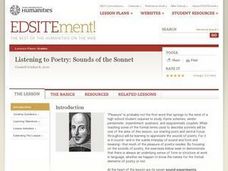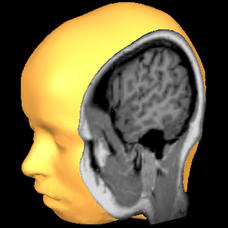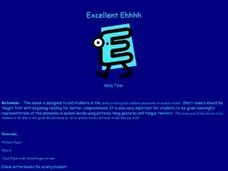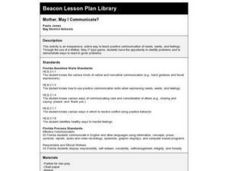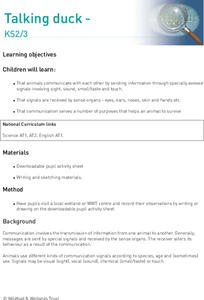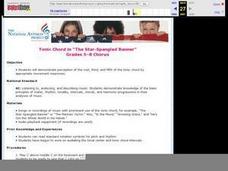Curated OER
Watch Your Conductor Like a Hawk
Students focus their eyes on the conductor in music class. The teacher uses a music sheet to isolate the musical elements of tempo, balance, and blend.
Curated OER
HIV/AIDS and Development
In this global issues worksheet, students conduct research on the the status of AIDS/HIV treatment in the world and respond to 4 short answer questions related to the topic.
Smithsonian Institution
General George Washington, Military Leader
Teach pupils the characteristics that make George Washington such an effective leader, especially in context of his time period. Scholars view artifacts, participate in group work, create lists, compare and contrast, and discuss as a...
Curated OER
Theater Arts/Creative Movement Lesson Plan
Here is a series of five exercises intended to bring movement, dance, and theater into the classroom. Intended for special ed classes, but appropriate for any grade, learners will pantomime, play pretend, dance, move, and create...
Macmillan Education
Self-Awareness and Respect
The eighth in a series of 23 life skills exercises focuses on self-awareness and respect. Groups record, on the provided worksheets, words and phrases that signal respect, and generate lists of behaviors that signal respect.
Perkins School for the Blind
What Do I Hear?
Being able to give positive reinforcers to a child starts with knowing what the child likes. Intended for children with blindness, this instructional activity gives you a way to determine the types of music your learners like best....
Curated OER
Fast or Slow?
Vestibular stimulation is an action or activity relating to balance and motion. To find out what kind of vestibular stimulation your learners with multiple disabilities enjoy best, follow these simple suggestions. You engage the child in...
Curated OER
Describing the Planets
Kids love learning about space! In this short plan, your young Spanish speakers read Los Planetas and talk about the nine planets. By the end, they should be able to name and identify each of the planets and add some descriptive words....
Houghton Mifflin Harcourt
Colors All Around: English Language Development Lessons (Theme 2)
A reading of the rhyme "Red Means Stop!" launches a three-week ELD/ESL study of color. The scripted daily lessons contained in the 32-page unit are packed with exercises, activities, and skill builders.
Curated OER
Listening to Poetry: Sounds of the Sonnet
High schoolers investigate how sound influences meaning in poetry by listening to sonnets. They write an analysis after listening to and reading sonnets.
Rainer Goebel
Brain Tutor 3D
The human brain is staggeringly complex, and its structure can seem impossible to grasp. This user-friendly app allows for exploration of the brain's anatomy, providing nomenclature, 3-D mapping, and functions.
Curated OER
Excellent Ehhhh
Students make the different e sounds and practice a chant about the e sounds. They use a letterbox to write different words utilizing the e sounds. They listen to a story about a dog named Red that emphasizes the e sound. They write a...
Curated OER
Growing a Winter Garden
Second graders listen to planting story, identify vegetables in pictures, and watch teacher demonstrate proper way to plant seeds in soil, and water. Students then plant seeds into their own containers.
Curated OER
A Sense for Technology
Students discuss American Sign Language. They work in pairs to review the fingerspelling alphabet and to spell a few common words. In addition. they
work with a partner to practice signs for 10 different words related to a selected...
Curated OER
Science for Technology
Students discuss sign language and learn how to spell some words. In this investigative instructional activity students work with a partner to write and perform sign language on a given topic.
Curated OER
MYSTERY PICTURES (Following Oral Directions)
Students draw pictures while following simple instructions. They discuss the importance of following directions explicitly. They discuss the differences between each child's work. They follow a second set of directions.
Curated OER
Mother, May I Communicate?
Students participate in a unique version of the game Mother, May I. They play the game to explore how to positively communicate their needs, wants and feelings, and to demonstrate how to react to problems.
Curated OER
The Fish Say Shhh
First graders identify the digraph /sh/ in written and spoken language. Students practice the production of the /sh/ sound through tongue twisters and riddles. They identify the initial and final placement of the new digraph /sh/ using a...
Curated OER
Spiritual Space
Students explore Italian Renaissance artwork. In this visual arts lesson, students examine "Madonna, Saint Thomas Aquinas, and Saint Paul'" by Bernardo Daddi. Students investigate the use of space, scale, and proportion in the work prior...
Curated OER
Expressive Body Part Identification
Young scholars participate in activities with Mr. Potato Head and Inspector Gadget. During the activity, they must request the body part they want to add to the body. They must state their request in a complete sentence and point to the...
Curated OER
Henry Howls
Let's learn the letter h! Elementary learners will hear the sound, learn a catchy tongue twister, and identify the sound in different words the teacher says. After some writing practice, read A House for Hermit Crab, by Eric Carle,...
Curated OER
Writing Conventions: Combining Sentences with Appositives
Young grammarians as well as language learners can benefit from a short presentation about using appositives to combine short, related sentences. After a brief definition of terms, pairs share their ideas and combine model sentences.
Curated OER
Talking Duck
Students study how animals communicate through their senses and signals. They investigate how animals survive using their communication skills and create a commercial based on the research.
Curated OER
Tonic Chord in "The Star-Spangled Banner" (Grades 5-8 Chorus).
Students demonstrate perception of the root, third and fifth of the tonic chord by appropriate movement responses. They analyze and describe music. Students listen to the middle C played on the keyboard and sing to it on the syllable do.









